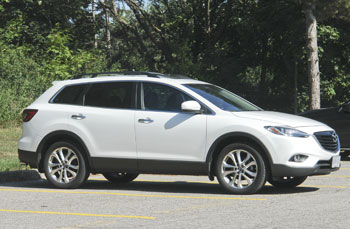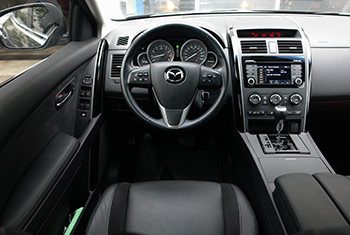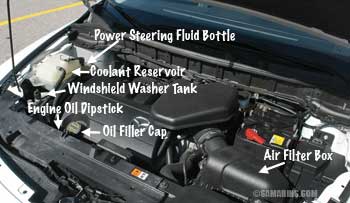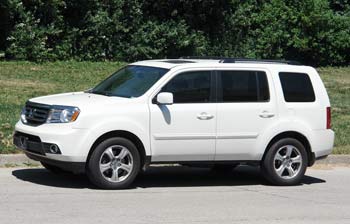2007-2015 Mazda CX-9: Pros and Cons, Common Problems
By Vlad Samarin Updated: January 12, 2024
This stylish seven-seater is not only roomy and practical, but sporty and fast: 0 to 60 in 7.3 seconds. The CX-9 handles like a heavy sporty sedan, and offers a smooth and refined ride.
It has a fully independent suspension with 18" or 20" wheels and comes with front- or all-wheel drive. This is a family vehicle you can enjoy driving. The Mazda CX-9 is a mechanical relative of the Ford Edge.
Pros:
- Sporty Design: The Mazda CX-9 features a sporty and stylish design.
- Third-Row Seating: With three rows of seating, the CX-9 offers a spacious and versatile interior, providing ample room for passengers and cargo.
- Engaging Driving: Known for its sporty handling and responsive steering, the CX-9 offers a more engaging driving experience compared to some competitors.
- Powerful V6 Engine: The CX-9 is equipped with a potent V6 engine, delivering strong acceleration and towing capabilities.
Cons:
- Fuel Efficiency: The CX-9's fuel efficiency is lower compared to some other midsize SUVs.
- Infotainment System: Older models have a less advanced infotainment system compared to newer vehicles, lacking some of the latest technology features.
- Reliability Concerns: Some reliability issues, such as transfer case, transmission, electrical problems, as well as a failing water pump will lead to expensive repairs.
- Expensive Maintenance: The 20-inch tires are costly to replace. Failing front end parts and wheel bearings lead to increased maintenance costs.
- Resale Value: The CX-9 will not hold its value as well as some rivals.
2007-2015 Mazda CX-9 Common Problems:
The majority of problems are relatively minor, including bad wheel bearings, seized brake calipers, a failing brake booster, leaking power steering hoses and brake pulsation caused by warped front rotors. Front end repairs and Check Engine light issues are fairly common too. Expensive problems include a failing all-wheel drive transfer unit (PTO), transmission, electrical problems and a bad water pump. Read more below:Blower Motor Relay: A faulty blower motor relay can cause the front or rear blower motor to stay on after the ignition is turned off. The repair is very simple: replace both blower motor relays in the main fuse box.
Sticking Liftgate Handle: Corrosion at the liftgate handle can cause the liftgate not to close fully. If the liftgate handle feels like it's sticking, soak its hinges with penetrating fluid. If it doesn't help, the handle will need to be replaced, which is not very expensive.
Water Slushing in the HVAC unit: An A/C drain could clog up causing water to collect inside the main HVAC unit under the dash. The first sign is a slushing noise from the blower fan when turning left. The repair is to unclog the A/C drain.
We found several videos describing the repair. If water damages the blower motor, it will have to be replaced, which is not very difficult; the front blower motor is located behind/under the glove box. An OEM blower motor from Mazda is expensive, however cheaper aftermarket units are available.
Code P0451: The Check Engine light with the code P0451 is often caused by clogged up fuel tank pressure sensor. Often the problem happens after the vehicle has been rustproofed. It's not very expensive part and is easy to replace.
Multiple Warning Lights, Rough Shifting: Corrosion at the one of the rear Blind Spot Monitoring System (BSM) modules can cause the BSM system not to work as well as many other electrical problems, including rough shifting of the transmission and several warning lights (AT, AWD, etc.) to come on.
There are two rear BSM modules at the sides of the car, behind the rear wheels covered by the rear bumper. If problems disappear when one the BSM modules is disconnected, the module is faulty. The part is expensive, but used modules are available on eBay.
Bad Brake Booster: A failed power brake booster can cause a hissing noise coming from the brake pedal area, a lack of brake assist and hard brake pedal. Replacing the brake booster will cost 2.5-3 hours of labor plus the part.
Power Transfer Output unit: PTO leaks and failures are common. The power transfer output unit is a part of the AWD system. It's attached to the transmission. The replacement is quite expensive ($800-$1,100). In some vehicles, the power transfer units were replaced under warranty extension SSP 92.
Advertisement
Ignition Coils: Failed ignition coils are can cause the engine to misfire and if not repaired in time even damage the PCM. Changing the spark plugs within recommended intervals wii reduce chances of ignition coil failures.
Rear Exhaust Heatshield: A rear heatshield could separate and rub against the propeller shaft, which could cause a screeching noise coming from the back of the vehicle. The heatshield will need to be replaced or re-secured. The repair is not very expensive.
Check for recalls at the NHTSA website.
Summary
The CX-9 is a sleek solidly-built 7-seater crossover with a strong engine. Avoid older and high-mileage models because if the water pump fails in the engine, due to its location, the repair will be costly. For the same reason, if your are buying a used Mazda CX-9, consider buying an extended powertrain warranty. Front-wheel drive models will be less expensive to own. When checking the car, testing the all-wheel drive system is a must given transfer case problems. Among competitors, the Toyota Highlander is more reliable and has a softer ride, but its third-row and cargo space is limited. The Toyota Venza is a similar 5-seater SUV. The Ford Edge rides on the same platform as the CX-9, but it doesn't have the third row.Related reviews:
Ford Edge 2007-2014
Nissan Pathfinder 2013-2020
Dodge Journey 2009-2019
Toyota RAV4 2006-2012
Honda Pilot 2009-2015
Ford Explorer 2006-2010
Toyota Highlander 2008-2013
Mazda CX-5 2013-2016
2007-2015 Mazda CX-9 Engine: The 2007 Mazda CX-9 was equipped with the 265-hp 3.5L Ford-sourced V6 engine. All later model years come with the 273-hp Ford-built 3.7L V6. It's a strong low-maintenance engine with plenty of low-end torque.
The only problem is that if the water pump fails at higher mileage, it will be expensive to replace due to its location: it's inside of the engine and is run by the timing chain. Replacing a water pump in this engine will cost 12-15 hours of labor plus the parts.
The oil capacity (with oil filter change) for the 2012 CX-9 is specified at 5.5 US qt (5.2 liters).
Timing belt or timing chain? The CX-9 V6 engine does not have a timing belt; it uses a timing chain instead. A timing chain doesn't need to be replaced unless it becomes stretched and noisy.
What to look for when buying a used Mazda CX-9:
Check used car history records for previously reported accidents and service history. When checking the car at the dealer's lot, test all electrical features including the air conditioner, audio system, power liftgate and other features. Avoid high-mileage vehicles.If the vehicle has a smart key entry system, test it carefully, as this system is prone to glitches. Make sure the vehicle has two keys, as an additional key is expensive.
During the test drive, watch out for humming and whining noises from the drivetrain. Read more: How to inspect a used car - illustrated guide. During the pre-purchase inspection, ask your mechanic to check for leaks and test the AWD system. Consider buying a good extended warranty for the powertrain to protect yourself from unexpected repairs.
2007-2015 Mazda CX-9 Interior: Inside, the CX-9 is very roomy, although the wide center console takes up some space in the front. Three rows of seats are standard.
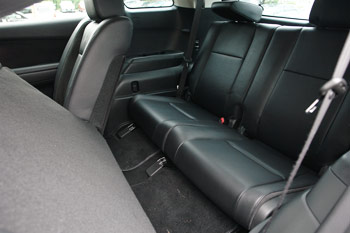 Mazda CX-9 third-row seats.
Mazda CX-9 third-row seats.With the third row up, you get 17.2 cu. ft. of cargo space in the back, which is more than in the Toyota Highlander, but less than in the GMC Acadia/Chevrolet Traverse twins. Third-row seats fold flat for more cargo space. Second-row seats fold too, although not completely flat.
2007-2015 Mazda CX-9 Handling and Ride: The CX-9 handles extremely well and is a pleasure to drive on long highway trips. The ride is on the firm side, but refined and fairly quiet. The first impression is like driving on rails.
Despite its heavy weight, the CX-9 feels quick off the line and sporty and secure on the road. The steering is precise and well-weighted. The AWD system is fully automatic and does not require any input from the driver. One thing we noticed though, the CX-9 all-season tires are not very good in the snow.
2007-2015 Mazda CX-9 Crash Test Scores: The 2007-2010 CX-9 scored five out of five stars in the government crash tests and has a four star rollover resistance rating. Antilock brakes and stability control are standard.
Mazda CX-9 Maintenance Tips: To keep your vehicle safe, have it regularly inspected; a quick check during a drive-through fast lube service is not enough. Watch out for leaks, if you notice drops on your driveway, have the vehicle checked out before lack of fluid that is leaking cause problems.
Recommended oil change intervals vary between 5,000 and 7,500 miles depending on driving conditions. The Mazda CX-9 engine uses the SAE 5W-20 oil type.
Check oil, coolant and power steering fluid levels regularly and top up if needed. The cabin filter is often neglected; it must be changed every 15,000-25,000 miles. Spark plugs need to be replaced every 60,000-100,000 miles, again, depending on driving conditions. This means that if you regularly drive in heavy city traffic, hilly terrain, dusty conditions, extreme hot or cold weather, your car needs more frequent oil changes, spark plug replacement and other maintenance. Timely spark plug replacements will help avoid more serious problems like failed ignition coils.
2007-2015 Mazda CX-9 Fuel Economy: The 2015 AWD Mazda CX-9 is rated at 16/22 mpg. This means that on a highway trip, the CX-9 can drive up to 422 miles (679 km) on one tank of gas. See the fuel economy numbers in the table.
| EPA Fuel Economy: | mpg city/hwy |
L/100 km city/hwy |
| 2011-2015 Mazda CX-9 FWD | 17/24 | 13.8/9.8 |
| 2011-2015 Mazda CX-9 AWD | 16/22 | 14.7/10.7 |
| 2007-2010 Mazda CX-9 FWD | 16/22 | 14.7/10.7 |
| 2007-2010 Mazda CX-9 AWD | 15/21 | 15.7/11.2 |
